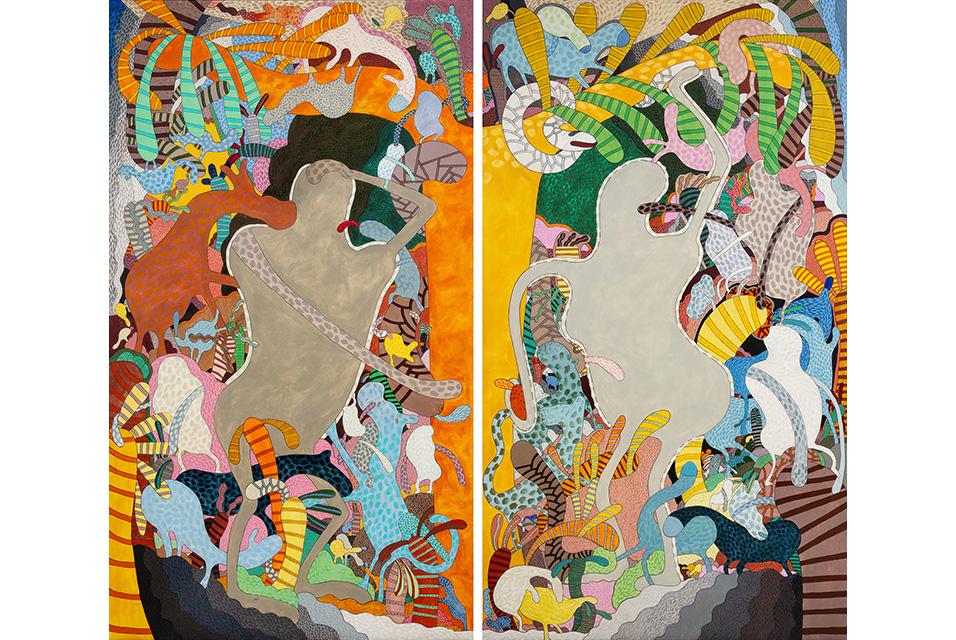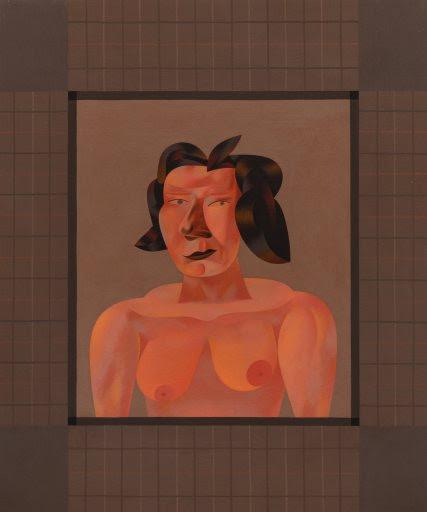One such highlight is the uncharacteristically large-scale diptych by Gladys Nilsson, Dipdick...Adam and Eve after Cranach, 1971, estimated at $20,000-30,000. This work playfully riffs on Lucas Cranach the Elder’s similarly titled Northern Renaissance masterpiece. Engaging the same energy as her more intimate watercolors but on a grander scale the work employs high key colors, dynamic patterns and whimsical interwoven bodies to reinterpret and reinvigorate a classic.
Two paintings from Karl Wirsum’s seminal Doggerel series of vibrantly electric colored and graphically edged anthropomorphic dogs will be reunited for the first time since the late 60s. With presale estimates of $40,000-60,000 and $50,000-70,000 each, Doggerel, 1966 and Doggerel III, 1967 interestingly come to market from two different collections. Originally purchased from a group exhibition at Dell Gallery in 1966 and the second Hairy Who? exhibition at the Hyde Park Art Center in 1967 respectively, the works have remained with the original buyers since. This pair of paintings illustrate Wirsum’s evolution from more open-spaced akimbo psychedelic abstraction to a full-frontal frenetic symmetrical figuration that became his signature approach through the rest of the 60s and beyond. Other Chicago artists of note featured prominently in the auction are Leon Golub, Richard Hunt, George Cohen and Gertrude Abercrombie.
The artist Jim Nutt was born in 1938 and studied at the School of the Art Institute of Chicago in the early sixties just as Abstract Expressionism was ceding the spotlight to Pop Art. Together with other students he and his wife, the painter Gladys Nilsson, formed a group that came to be known as the Hairy Who. Allied to the Chicago Imagists, their style was a kind of surrealizing Pop, with a cartoonish, eschatological gonzo character that earned them a swathe of group shows across the US and beyond from 1966 through to the early 70s.
Since the mid-90s Nutt has focused exclusively on painting female heads; the works in this current exhibition date from 2010 to 2016. They are not portraits, although the artist does admit to being a close observer of people in the street. Writing in the New Yorker, David Nolan referred to them as a kind of ‘geek classicism’. The works are of uniform size, and draw one in with a power to match a Lucas Cranach Adam and Eve. Nutt uses thinned acrylic paints. This is significant because the color used this way has a translucency that means he has to build up many layers of paint to achieve the desired effect. He is interested not in brush strokes, the paintings are entirely without gesture, but in the impasto brought about by this layering which in turn lends the heads an extraordinary three-dimensionality.


























